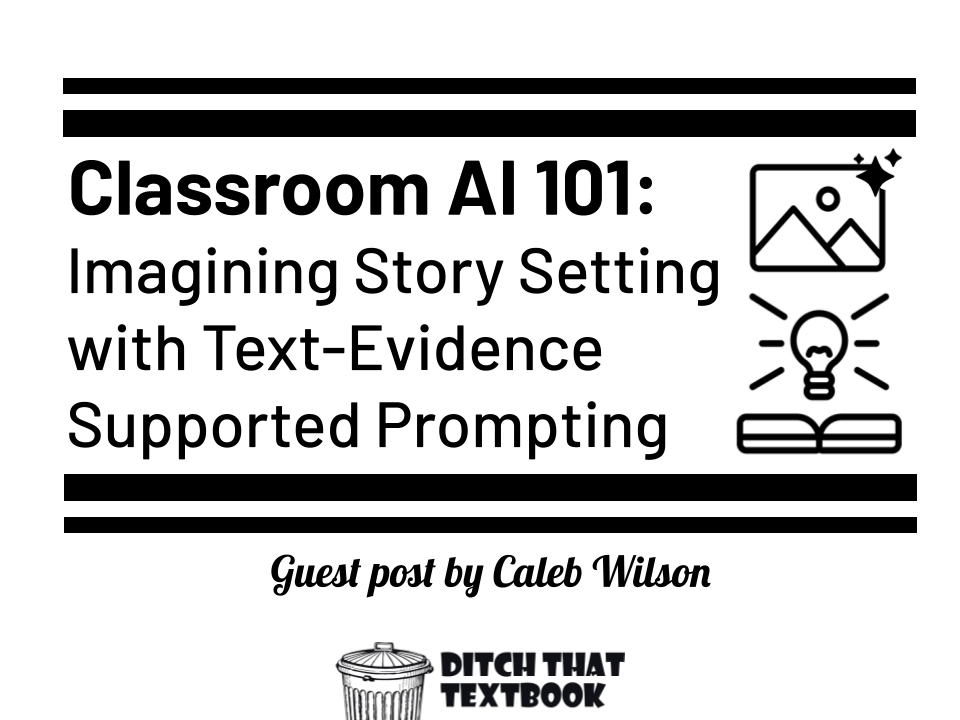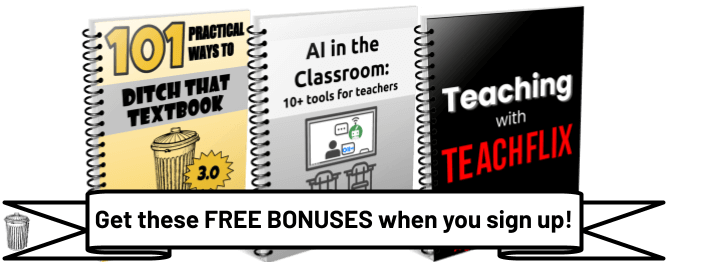
This post is written by Caleb J. Wilson, a District Coach of Instructional Technology and Innovation for Worcester County Public Schools, Maryland, where he leads the AI4WCPS initiative to integrate artificial intelligence into his school district. His work emphasizes the importance of accessibility and practical innovation in education, ensuring all students are prepared for the future's demands. You can connect with Caleb at @mrCalebJWilson on Twitter/X.
Imagine your favorite story. What sights, sounds, and feelings from the story come to mind? Can you see the setting? The characters? Where does the most important scene take place?
Those visuals created in our minds are the results of writers who understand the importance of vivid details.
What if we could take those details and generate those same images we have in our minds?
To see the story vividly, like the AI-generated images from Robinson Crusoe below ...

ChatGPT

Google Gemini

Leonardo.ai
This illustration wasn't included in the book. It was created with an AI image generator.
But how? And how can we do it in our own classes?
In this post, we'll explore how generative AI can transform traditional reading assignments into immersive visual explorations, enabling students to identify and analyze text evidence in a whole new light.
Imagining Story Setting with Text-Evidence Supported Prompting
A key anchor standard for the Common Core State Standards is the ability for students to use text evidence to support conclusions drawn from texts (CCSS.ELA-LITERACY.CCRA.R.1).
What if in addition to having students use a graphic organizer ad simply listing the text evidence, they were tasked with using that text evidence to create a prompt for an image generator like ChatGPT-powered Dalle-3, Adobe Firefly, or Canva, to create images based on the details of the setting from the story!?
Let's see what that lesson might look like.
Note: You can level this lesson up or down depending on your grade level but I will use a middle school classroom of 12-13 year olds for the basis of this lesson.
- Provide the text that you would like the students to use to gather evidence. I will be using various excerpts from Robinson Crusoe. This novel has many descriptions of settings that have a massive impact on the story - from Crusoe’s initial view of the island atop the hill, or his descriptions of his “settlement” that he would call his home while on the island.
- Students find key details that describe the setting, annotating the text either individually or together.
- Students will then craft a prompt to create an AI-generated image that represents the text evidence that they found and includes the details they annotated.
- Students can then analyze the image. They look for evidence of the text in the AI-generated image. They can determine any improvements and add them to the prompt and have a new image generated.
- Finally, students with different settings, could trade images, and be given fresh text excerpts to use along with the image as a guide to find those elements in the story.

Notes: Description of the island:
- Page 82 “My next work was to view the country, and seek a proper place for my habitation, and where to stow my goods to secure them from whatever might happen.”
- “There was a hill not above a mile from me, which rose up very steep and high, and which seemed to overtop some other hills, which lay as in a ridge from it northward.”
- “. . . that I was in an island environed every way with the sea: no land to be seen except some rocks, which lay a great way off; and two small islands, less than this, which lay about three leagues to the west.”
- “I found also that the island I was in was barren, and, as I saw good reason to believe, uninhabited except by wild beasts, of whom, however, I saw none. Yet I saw abundance of fowls, but knew not their kinds;”
- Page 92, describes his “home” that he started to build on the island.
Prompt created from relevant text evidence above:
“Imagine a man dressed in tattered clothing as a result of a shipwreck atop a large hill overlooking a semi-barren island with other smaller hills below. His view is of a large island covered in trees, with a small cove leading to a river into the trees below. There are also birds and other fowl in the distance, and far off in the vast, clear, blue ocean are some smaller islands barely visible and some scattered rocks in the sea.”
Image generations:
Click through to see the different images generated by three different AI tools.

ChatGPT

Google Gemini

Leonardo.ai
Why this works
This method not only encourages students to delve deeper into textual evidence but also allows them to visualize literary settings in vivid detail, bridging the gap between abstract text and tangible visualization. As students iterate on their prompts and refine their visual outputs, they engage in a critical thinking process that mirrors the analytical reading strategy—looking for details, inferring meaning, and synthesizing information.
This hands-on experience with AI tools like ChatGPT-powered Dalle-3, Adobe Firefly, or Canva, transforms reading assignments from passive tasks to active, creative explorations, making the narrative world leap off the page and into the realm of visual reality.
Lesson extensions
Character Visualization: Extend the activity by having students create prompts to visualize characters based on textual descriptions. This can help students analyze character traits, clothing, and demeanor, deepening their understanding of character development and motivation.
Historical Context: For texts set in historical periods, students can research and include historical details in their prompts to generate images that reflect the era's setting, attire, and technology. This approach can enrich their understanding of the historical context and its influence on the narrative.
Creative Writing: Encourage students to write their own short stories, using AI to visualize settings, characters, or key events. This activity fosters creativity, writing skills, and the ability to translate abstract ideas into concrete images.
By expanding the use of AI in the classroom through these extensions, educators can offer students a multifaceted learning experience that not only enhances their reading comprehension and analytical skills but also fosters creativity, critical thinking, and a deeper appreciation for literature and history.
As we continue to explore the possibilities of instructional technology, it's clear that the future of education is bright with the promise of innovation, engagement, and a deeper connection to the world of knowledge.



Cenforce 100mg for addressing erectile dysfunction (ED) and enhancing sexual experiences. This medication, containing sildenafil citrate, offers a reliable option for those seeking to overcome ED and improve performance in the bedroom. With its proven effectiveness, Cenforce 100mg empowers individuals to reclaim confidence and enjoy satisfying intimacy. However, it’s essential to use Cenforce 100mg esponsibly and under medical guidance to ensure safety and maximize benefits. Embrace the opportunity to unlock a fulfilling sexual journey with Cenforce 100mg.
Visit Now:- https://rejicspharma.com/index.php/product/cenforce-100-mg-sildenafil-tablet-100-tablets/